Monarch caterpillars are easy to raise if you have Milkweed.
With the increased awareness of the importance of butterflies in ecosystems, there is now an industry of commercial butterfly breeding operations, which includes the Monarch butterfly among them. This is in addition to the popularity of raising Monarchs in homes or as school projects, for example. There are many sources where one can buy a 'Monarch rearing kit'.
One issue that can arise from ‘mass rearing’ (more than 100 caterpillars in a setting) is the potential spreading of diseases and parasites, which can then contaminate wild populations. Another one appears to be the potential decrease of the Monarch butterfly capacity to migrate successfully. And here's another article about the drawbacks of 'captive rearing' Monarchs, while emphasizing the importance of enhancing the species natural habitat for its preservation.
There are many ways Monarch populations can be increased. An important one would be to restore, increase and protect their natural habitats and creating new ones, for example by planting Milkweed, the Monarch caterpillar exclusive food source.
 |
| Swamp milkweed |
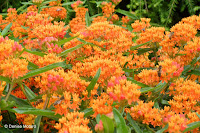 |
| Butterfly milkweed |
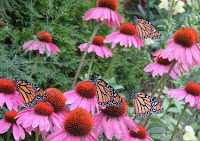 |
| Nectar-rich Purple coneflower |
Below are some photos of a very simple (and inexpensive) arrangement to raise Monarch caterpillars. You can use some kind of jar or glass of water and put cut Milkweed stems in them. Then you put those containers onto some kind of tray to collect the caterpillar droppings. The water needs to be changed every day, as some droppings will fall into it.
 |
| An older arrangement |
 |
Monarch caterpillar in 'J'
phase, and 2 chrysalises |
 |
| Monarch chrysalis in Swamp milkweed |
The jars don't need to be placed into full sun, but close to a window would be good. It's important to make sure the plants don't touch anything around them, such as curtains or screen. When caterpillars are searching for a spot to pupate, they can crawl all over the plants for a long time before finding what they look for. They can also stretch out quite a bit when doing this (see photo below).
From my experience I found that those caterpillars don't always seem to like the narrow leaves or the flower stems of Swamp milkweed to pupate. So I added stems of lilac, and it did the trick (photo below). Lilac leaves are larger and slightly bent along the middle, providing an ideal 'umbrella' shelter for the pupating caterpillar.
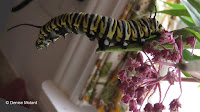 |
| Looking for a spot to pupate |
 |
| Lilac leaves provide better shelter |
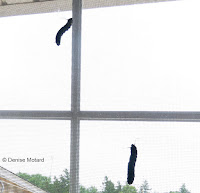 |
| Crawling up the window to pupate |
Initially, as soon as a caterpillar was turning into a chrysalis, I was cutting the leaf where it was attached, and pasting it in a place where they would not be disturbed (like in these photos below).
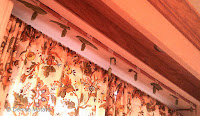 |
| 1st line up of Monarch chrysalises |
 |
| 2nd line up of Monarch chrysalises |
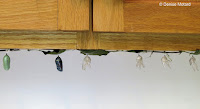 |
| Last row of Monarch chrysalises |
But after I read about the fact that an emerging Monarch butterfly will somehow 'imprint' on its location and 'remember' it, I decided to no longer let the caterpillars turn into a chrysalis inside.
WHAT I DO NOW: Instead, once the caterpillars clearly shows signs of searching for a pupating spot, I take them outside and place them in a large Wisteria plant at a high level (photo below). This provides them ample shelter, and once they emerge as a butterfly, they can safely dry their wings in the thickness of that foliage.
 |
| Two Monarch chrysalises in wisteria |
After two years raising Monarch caterpillars and observing their behavior and making notes, takings photos and videos and reading on the topic, I have now decided to focus on making my garden more Monarch-friendly as a priority.
This garden is now a Certified Monarch Waystation, a program by Monarch Watch to encourage people to grow Monarch-friendly gardens and other areas.












